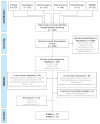Biocompatibility of Root Canal Sealers: A Systematic Review of In Vitro and In Vivo Studies
- PMID: 31818038
- PMCID: PMC6947586
- DOI: 10.3390/ma12244113
Biocompatibility of Root Canal Sealers: A Systematic Review of In Vitro and In Vivo Studies
Abstract
(1) Aim: To perform a systematic review of the literature on the biocompatibility of root canal sealers that encompasses the various types of sealers that are commercially available as well as both in vitro and in vivo evidence. (2) Methods: This systematic review has been registered in PROSPERO (ID 140445) and was carried out according to PRISMA guidelines using the following databases: PubMed, Cochrane Library, ClinicalTrials.gov, Science Direct, and Web of Science Core Collection. Studies published between 2000 and 11 June 2019 that evaluated cytotoxicity (cell viability/proliferation) and biocompatibility (tissue response) of root canal sealers were included. (3) Results: From a total of 1249 studies, 73 in vitro and 21 in vivo studies were included. In general, studies suggest that root canal sealers elicit mild to severe toxic effects and that several factors may influence biocompatibility, e.g., material setting condition and time, material concentration, and type of exposure. Bioactive endodontic sealers seem to exhibit a lower toxic potential in vitro. (4) Conclusions: The available evidence shows that root canal sealers exhibit variable toxic potential at the cellular and tissue level. However, the methodological heterogeneity among studies included in this systematic review and the somewhat conflicting results do not allow a conclusion on which type of sealer presents higher biocompatibility. Further research is crucial to achieve a better understanding of the biological effects of root canal sealers.
Keywords: biocompatibility; cell death; endodontics; root canal filling materials; root canal sealer; systematic review.
Conflict of interest statement
The authors declare no conflict of interest.
Figures



References
-
- Hargreaves K.M., Berman L.H. Cohen’s Pathways of the Pulp. 11th ed. Elsevier; St. Louis, MO, USA: 2016.
-
- Johnson W., Kulild J.C., Tay F. Obturation of the Cleaned and Shaped Root Canal System. In: Hargreaves K.M., Berman L.H., editors. Cohen’s Pathways of the Pulp. Elsevier; St. Louis, MO, USA: 2016. pp. 280–322.
-
- Grossman L. Endodontics. 11th ed. Lea & Febiger; Philadelphia, PA, USA: 1988.
-
- Ørstavik D. Materials used for root canal obturation: Technical, biological and clinical testing. Endod. Top. 2005;12:25–38. doi: 10.1111/j.1601-1546.2005.00197.x. - DOI
Publication types
LinkOut - more resources
Full Text Sources

